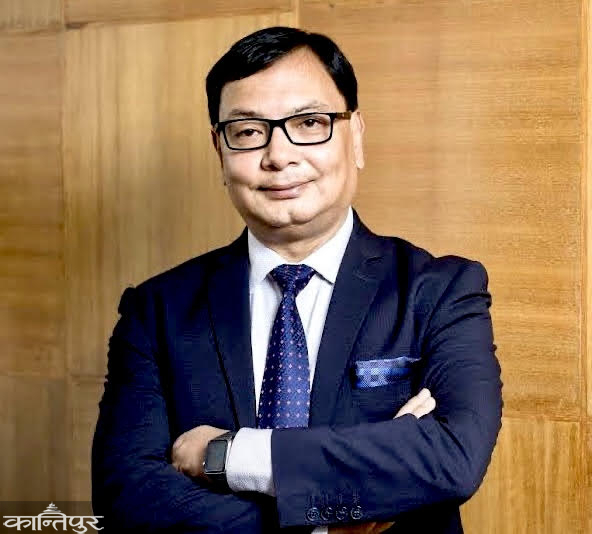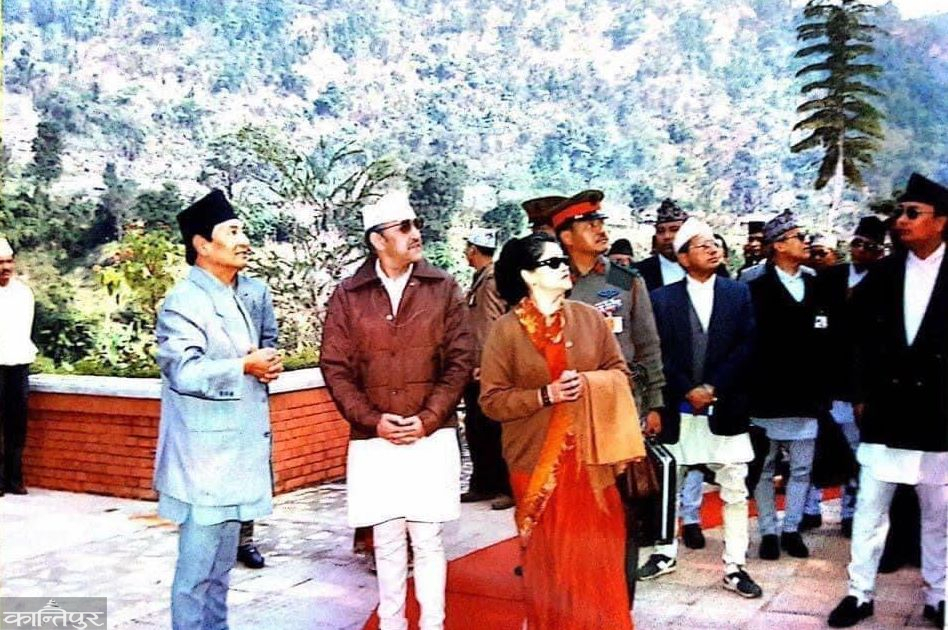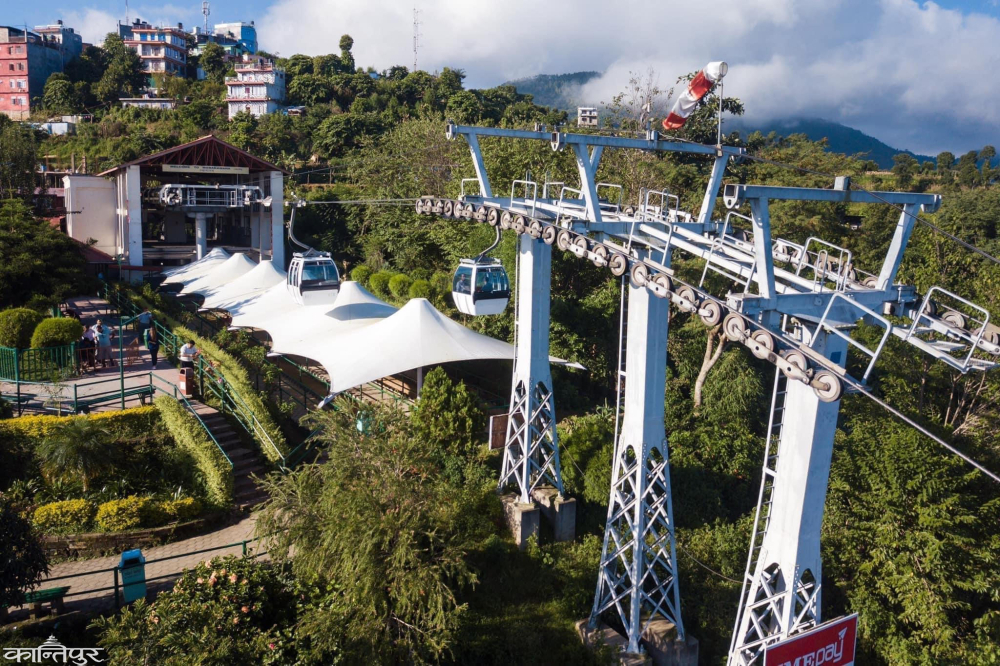Desire to introduce only in Nepal
We use Google Cloud Translation Services. Google requires we provide the following disclaimer relating to use of this service:
This service may contain translations powered by Google. Google disclaims all warranties related to the translations, expressed or implied, including any warranties of accuracy, reliability, and any implied warranties of merchantability, fitness for a particular purpose, and noninfringement.


Laxman Babu Shrestha of Gorkha would not forget to look at the surrounding hills when he sat on the square to kill his fatigue by walking. Because, those hills used to attract him. One day, while watching like this, he saw clouds moving from one hill to another. Then he thought, how easy it would be if he could walk like a cloud.


How easy it would be to reach Kathmandu if such technology was available. At that time, it took four to five days to reach Kathmandu. Later, the motorway was gradually built. The means of transport started running. As a result, it became easy to reach Kathmandu from Gorkha.
In the beginning, Lakshmanabu was known as a construction businessman. From the year 2033, he started the work of Chitwan Co-E i.e. Chitwan Construction Engineering. As the construction company of 'A' category did the first contract work in Chitwan, the name of the construction company was kept as Chitwan Co-E. In 2016, Laxman Babu's family came down from Gorkha to Chitwan. His younger son Rajeshbabu told that they also came down to Chitwan along with their father and started living in Chaubisakoti.
Lakshmanabu, the founder of Manakamana Kewalkar, has passed away. He died 10 years ago during treatment at Medanta Hospital in India. However, Mankamana Kevalkar, a passenger carrier that he started, has now become a brand. Now, even though there is a competition to build Kevalkar to reach the monastery all over the country, it is no exaggeration that Mankamana Kevalkar was the first to show the way.
Mankamana Kevalkar did not achieve this success. Taking a huge risk, Lakshmanabu invested in Kevalkar. 'Dad went to Europe for business, he saw a ropeway cable car there,' said Rajeshbabu, 'During his childhood, father used to think how easy it would be to travel from one mountain to another if there was some technique to go from one mountain to another. , then returned to Nepal to see if it can be made in Nepal as well.'' Rajeshbabu said that his father returned from abroad with the determination to invest only in cars. Until that time, people in Nepal had not become mere carers. There was a ropeway for carrying goods.
Rajeshbabu said that after not finding a suitable way to reach the Mankamana temple located in Gorkha, he decided to build a Kevalkar connecting Kurintar (Ichchakamana Rural Municipality-4) of Chitwan to Mankamana (Sahid Lakhan Rural Municipality-3) of Gorkha. Manakamana Darshan Pvt Ltd was established on 22nd November 2053. The construction work started from the end of January 2054 and Mankamana Kevalkar was put into commercial operation from 8 November 2055. The Kewalkar was inaugurated by the then Crown Prince Dipendra Shah. Now Kevalkar has completed 26 years of operation. Kevalkar has reached a height of 1,302 meters. At that time Kevalkar was considered new. People were afraid to climb,' said Rajeshbabu, 'Many of them came back just to see. He saw that those who came to climb were scared and returned without being able to climb. Some even say like an airplane.
Previously, it was difficult to manage the arrival of 1,500 to 2,000 passengers in a single day. 'Kevalkar is not only an attraction, it is only a means of transport,' says Rajeshbabu, 'There are those who say that when so many Kevalkars are operating, Mankamana has/has not affected Kevalkar, but there is no competition between Kevalkar and Kevalkar, only there is competition for destinations.' As more people come, he says, 'This is a religious destination area, not only in Nepal, it is famous worldwide.' 'When we were young, Manakamana was known as a major religious destination, we used to walk there,' said Rajeshbabu, 'Father has taken forward the concept of religion and tourism to build Kevalkar in Mankamana.' Tourist traffic used to come to a standstill. The tourism industry here was dependent on foreign tourists. He said that when Kevalkar was launched by connecting religion and tourism, it started with the assumption that domestic tourists would reach it. "We had to decide what the investment would be, how to raise the investment was equally difficult, it was not a matter of becoming a mere car with a small investment," says Rajeshbabu, "At that time investing 650 million was a big deal, now even 3 billion rupees is not enough for the same standard." Of which 70 percent. Banks were the only investment.

At that time, banks and financial institutions were afraid to invest. Later, under the leadership of Nepal Bank, National Commercial Bank and then Nepal Bangladesh Bank invested. Since it was a time of conflict, it was difficult to conduct the service as expected. "Due to the conflict, it was very challenging to start a new service," he says, "but we did not get as many passengers as expected in two/four years of operation, but later we got good success." However, when starting the service, the company had set a goal of repaying the loan in 5 years. "Although we could not repay the loan as per the target, we managed to repay the loan within 7 years," he said. As the manufacturing company is its own, Chitwan Co-E studied only when making Kevalkar. After that, Doppelmer, an Austrian car manufacturing company, helped during the construction. The main work of
design was done by this company. The other design work was done by senior engineer Ramhari Shrestha of Nepal. The help of some foreign technicians was also taken. He said that they have also done the engineering procurement construction (EPC) contract of Annapurna Kevalkar in Kaski. Ramhari also worked on that.
Kevalkar was developing the habit of traveling in Nepali. Even at that time there were Nepalese who used to visit Chitwan, Lumbini, Pokhara. If the desire can be made easy, many tourists will come. The restaurants were brought into operation two years after Kevalkar was put into operation. At that time there was no way to go to Mankamana. The goods were carried in Khachhad and transported to nearby villages through Mankamana. In Dandapakha, it was not common to make a car and provide service. Kevalkar's tower was connected by helicopter. When helicopters were not an option. "We assembled the tower in Kurintar and took it by lifting. At that time, there were Russian pilots, they knew about it," says Rajesh Babu, recalling the old days, "Then we installed the tower with their help, we installed only 16 out of 20, and we installed four later." He told that the tower connection work was done in 3 days.
It took a long time to clear the goods from Birganj customs. But according to his efforts, he was able to serve easily. Since it started during the war, there was no rush of passengers. At that time, within two/three years of starting the service, the Maoists bombed the tower. "While starting the service, we thought it would be good if 4/5 lakh people came," he said, "later more than 88,000 people started commuting every month." Since the launch of Kevalkar, 1 crore 84 lakh 97 thousand 428 passengers have taken the service. Only 1 lakh 2 thousand 590 passengers took the service in February. Till February of the current financial year, only 7 lakh 5 thousand 62 passengers have boarded Kevalkar.
Last year, 1.1 million passengers arrived. In 8 months of the current financial year, 7 lakh people have been displaced. "Last year, 740,000 passengers used the service in 9 months," he said. 34 have been added.
Currently, the number of passengers reaching Mankamana by Kevalkar is high. Operating schedules have to be increased to manage that pressure. On an average, four thousand passengers come every day. "On some days, 10/11 thousand passengers come on the same day," he said, "During 25 years, there was an analog system, it has also become very old, now we are going to a digital system, the first phase of upgrading to a digital system called Doppelmer Company's Disconnect" We have completed it in the year 2021. It cost about 9 crores. "In July of the next financial year, we are doing the second and third phase work simultaneously, the whole system will change," he said, "the current drive system will come next, the control system itself will be changed and will be digital." can be solved. In the next phase, the control system communication only will be completely changed and will be as classy and new as before. 45 crores will be invested for its overall upgradation. which will increase its lifespan. "Its lifespan will increase by another 20/25 years," he said. "However, we are going to change the main stick before that time," he said, "we are going to change that communication should be digital only." The stick has already arrived. Kevalkar will be closed in July/August. It will resume from October. But he says that it will run on a completely new system. Currently, Kevalkar has given direct employment to 175 people and there are many more who are getting indirect employment. Only after Kevalkar came into operation, the opening of hotels and restaurants around Manakamana and Kurintar increased. "My father used to say that development leads to development. Earlier, few knew about Kurintar apart from the locals," says Rajeshbabu, "Most people only knew about Malekhu, Mugling, now you can hardly find anyone who doesn't know about Kurintar." Nepalis, 26 percent Indians and other foreign passengers are 4 percent. This Kevalkar has a distance of 3.01 km. It takes 10 to 12 minutes to reach Manakamana from Kurintar. 6 passengers fit in a coach. Initially, Kevalkar was plying from 9 am to 5 pm. Now it is run on Saturdays from 6:30 am to 8:00 pm and on other days it is run from 7:30 am to 5:30 pm. In the evening, the car is brought to Kurintar and parked.
In the earthquake of Baisakh 12, 2072, Kevalkar was running. As it was a Saturday, there was a lot of traffic. "On that day, the number of passengers who reached Manakamana temple by Kevalkar was around 5 thousand," said Rajeshbabu, "After the earthquake, we stopped the Kevalkar for some time and first ran it as a test, then we brought all the passengers who were in Manakamana to Kurintar by Kevalkar." But it was difficult during the Covid. . Kevalkar was closed for some time. Rajeshbabu narrates that later the Nepalese came and made the car easy to run.
Now his three sons Rajubabu, Roshanbabu and Rajeshbabu are trying to fulfill Lakshmanbabu's thoughts and dreams. Residents of the affected areas have been given concessions to travel by car only. As part of social responsibility, 1/1 percent of the total income from the sale of only car tickets has been supported to Sahid Lakhan Rural Municipality and Ichchakamana Rural Municipality. Rajeshbabu said that they are also providing free ambulance service on behalf of Mankamana Kevalkar in both rural villages.
Rajeshbabu said that now there are many people who come to Dandakanda and ask them to make Kevalkar as they wish. "There is a big fair in the hills near us, there are many people who come saying that they have to build a Kevalkar," he says, "It is not a matter of making a Kevalkar just because there is a fair, but there are many places in Nepal where Kevalkar can be operated, for that the motor road must have reached the lower station." Elsewhere too, the idea of making Kevalkar is soon reached. 'Father's dream was that Kevalkar would fit all over Nepal, at that time we did not find any area like Mankamana, we did that survey even in Swargadwari of Pyuthan,' he says, 'When we went to survey, it was a time of conflict, a bomb exploded nearby, and then we could not proceed with further work.' break Manakamana resort is currently being constructed within Manakamana Kevalkar Hata at a cost of 55 crores to attract tourists. The 40-room resort will have a swimming pool, health club, meeting seminar hall and restaurant. It is said that the resort will be operational by the end of 2024. "We started by saying that we need a good resort in Mankamana. People who come to visit the temple used to not stay even one night in Mankamana. Now they have started to stay. Now we have to create an environment where they can stay for at least two nights," he said. You can go to Mahadev Shaktipeeth, you can see beautiful hills, you can run homestays in this place.'' Where 600,000 guests can be accommodated annually. "7/8 resorts of our standard can be opened, including ours, two are opening," said Rajeshbabu, "within the next four/five months, we will inform everyone about the resort we are going to build."



 २८.१२°C काठमाडौं
२८.१२°C काठमाडौं

















